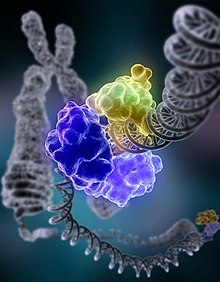Three scientists share 2015 Chemistry Nobel Prize for DNA repair research
Thursday, October 8, 2015

Image: Tom Ellenberger.
Yesterday, Göran K. Hansson, permanent secretary of the Royal Swedish Academy of Sciences, announced this year's Nobel Prize in Chemistry is awarded to three scientists for their work on DNA repair.
Tomas Lindahl, Paul Modrich and Aziz Sancar showed how damaged DNA is repaired and genetic information is safeguarded by the cells at the molecular level.
Swedish scientist Tomas Lindahl found that DNA molecules decay too quickly for life, or evolution, to be sustainable. This led to the discovery of base excision repair, a cellular mechanism that repairs damaged DNA by removing erroneous sections and replacing them.
Turkish molecular biologist Aziz Sancar mapped nucleotide excision repair, a DNA repair mechanism that targets larger-scale damage caused by mutagens and ultraviolet radiation.
US professor of biochemistry Paul Modrich showed how errors caused during DNA replication are usually rectified. DNA mismatch repair increases the precision of DNA replication when cells divide.
The prize is shared 1/3rd to each scientist.
Related news
- "2006 Nobel Prize in chemistry for insight into cells" — Wikinews, October 4, 2006
Sources
- "The Nobel Prize in Chemistry 2015 - Prize Announcement" — Nobel Media, October 8, 2015 (date of access)
- "The Nobel Prize in Chemistry 2015 - Tomas Lindahl, Paul Modrich, Aziz Sancar" — Nobel Media, October 8, 2015
- "The Nobel Prize in Chemistry 2015 - Press Release" — Nobel Media, October 7, 2015
- Katie M. Palmer. "DNA Repair Discoveries Get the Nobel Prize in Chemistry" — Wired (website), October 7, 2015
External link
- Class for Chemistry. "Scientific Background on the Nobel Prize in Chemistry 2015 - mechanistic studies of DNA repair -" — Royal Swedish Academy of Sciences, October 7, 2015


